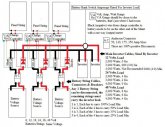I'm off grid, so redundancy (and dirt simple to repair/replace) is a HUGE deal for me.
Having started 20+ years ago, my equipment is most certainly showing it's age.
No tracking to the Watt, no combined units, no connectivity that's available now.
You are dead correct with starting at 48 volts instead of trying to beat big power out of a 12 DC side.
In my opinion, anything above 2,000 Watts should be 24 Volts,
Anything above 3,000 Watts should be 48 Volts.
It just makes things SO much easier...
For redundancy on a large system, I'd have a very serious look at micro inverters on the panels that transmit in high voltage AC.
A bunch of savings in losses, and any given panel/inverter can fail with the system staying running.
I'm a fan of modular rather than combined in one big unit,
Any one given smaller component can fail without crashing the system entirely, and let's face it, smaller modular components CAN be replaced for a lot less that having the combine unit sent in for service and doing without until it's returned.
I can be crippled on any component, but not killed...
I posted this earlier as a 100% redundant system, any single component can be deadline for maintenance and the system stay up at somewhat reduced capacity.
It's also expandable for some starting small but wanting to expand later on as budget allows.

Nothing fancy or integrated, all modular, voltage to suit, and allows for mixing/matching panel, charge controllers, battery banks, inverters, etc.
The old 'Smaller' become back up to the newer/larger, but you are never entirely dead, just crippled from what you had before any given failure.
I use an automatic transfer relay on primary power, that defaults to secondary when the failure happens,
In the diagram I show a manual transfer switch,
My system has a lot of other add-ons, but this is the dirt simple version,
Common battery cable connectors for DC disconnects, no way for charge controllers/stronger battery banks to back feed other older/smaller banks, desulfidators for lead/acid strings sided to the particular batteries in that string, etc.
Redundancy *Might* mean different things to different people, but after 20 years, making what you have comparable with everything else you have allows ultimate redundancy since I can use whatever pops up, from 1900 Edison batteries, to huge lead/acid industrial equipment batteries to LiFePo4 batteries sitting right next to each other happy as can be.
If the 4,000 watt inverter fails, the old 2,500 watt kicks in, I'm crippled, not dead,
And you don't have to pay ultra-premium price for cascade inverters to be redundant.
I loose some Watts, nothing more than one smaller panel can produce,
The AC transfer switch consumes about 7 Watts, and idling second inverter eats about 10 Watts, but an inverter that 'Wakes' on demand would lower that to about 1 Watt, diodes eat Wattage but are 100% foolproof protection for the battery strings,
It's just not enough to worry me since a single cheap panel makes up the losses...
I'd love to have one of the new super slick interconnected inverter racks with ultimate redundancy,
One part of a system like that you can't fix yourself is the connectivity, given a single processor or cable fail, one software/program glitch and the entire thing is down for the count...
And I'm no computer expert! I can't get my Bluetooth to work half the time.
Hard wire, mechanical positive disconnects, etc,
In a failure/emergency I don't ever want to be at the mercy of 'Customer Service', trying to download trouble shooting software, and deal with 'Authorized Service Centers'.
Find the fail, replace the fail, get back to full strength and *IF* there is warranty, let them sort it out on MY schedule...
The bump to exotic batteries freed up conventional charge controllers, so more 'Spares' in the box, and I just bout two LiFePo4 controllers to start with, so when lead/acid string gets replaced, so does the charge controller and I order another one...
It's not for everyone, not everyone wants to educate themselves/equip for forwards/backwards compatibility,
I didn't have that choice, and I haven't had to reset a clock in 14 years, so the redundancy thing is ironed out here.
Take any/all of this for what you paid for it, use it if you can...







